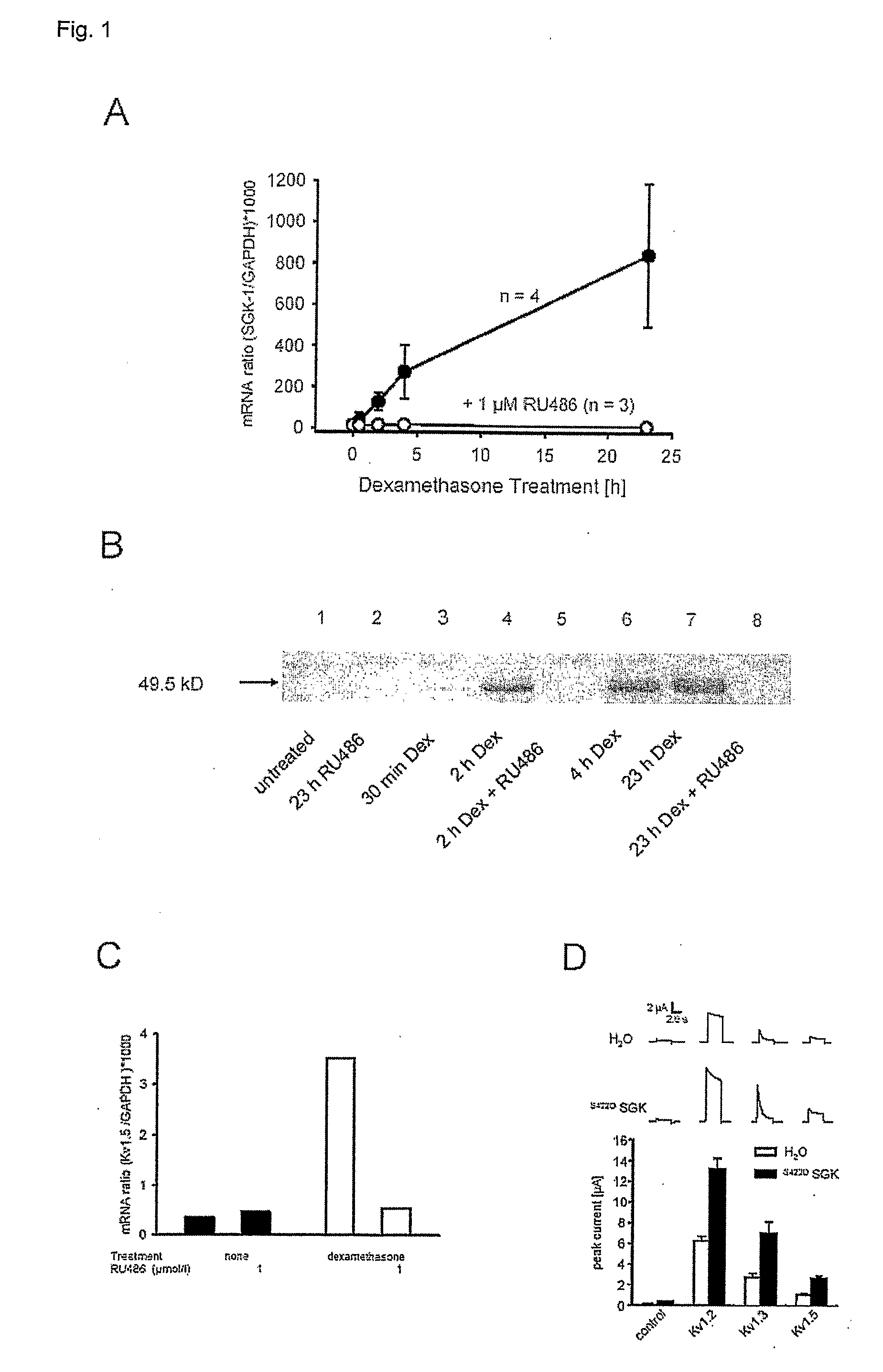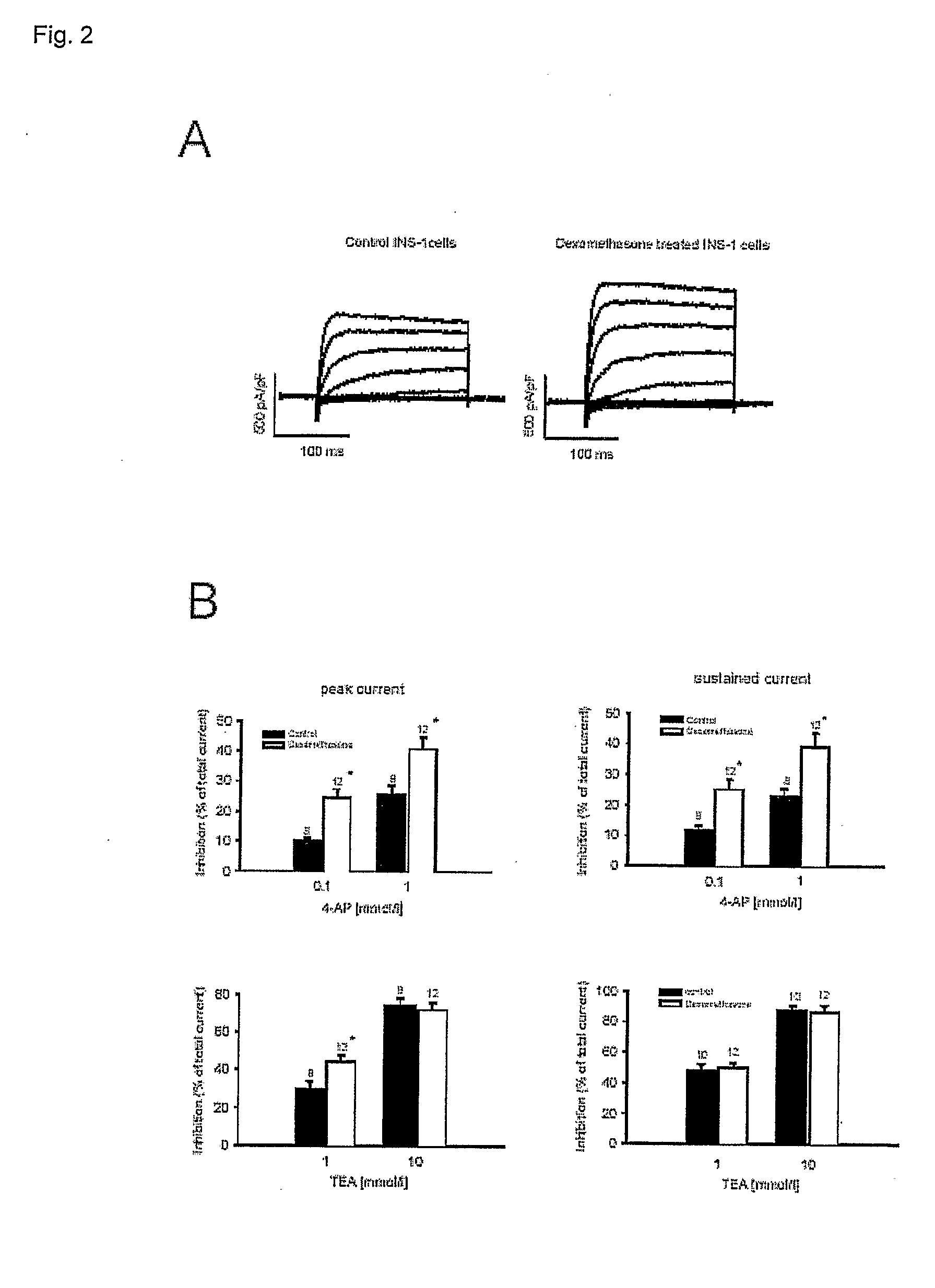Methods for altering insulin secretion
a technology of insulin secretion and method, which is applied in the field of methods for altering insulin secretion, can solve the problems of allowing therapeutic intervention, remained elusive, and remains a matter of debate on the molecular mechanism, and achieve the effects of restoring insulin secretion, reducing glucocorticoid, and reducing glucocorticoid
- Summary
- Abstract
- Description
- Claims
- Application Information
AI Technical Summary
Benefits of technology
Problems solved by technology
Method used
Image
Examples
example 1
Generation of Sgk1− / − Mice
[0035] A conditional targeting vector was generated from a 7-kb fragment encompassing the entire transcribed region on 12 exons (Wulff et al., 2002). The neomycin resistance cassette was flanked by two loxP sites and inserted into intron 11. Exons 4-11, which code for the sgk1 kinase domain, were “floxed” by inserting a third loxP site into intron 3. A clone with a recombination between the first and third loxP site (type I recombination) was injected into C57BL / 6 blastocytes. Male chimeras were bred to C57BL / 6 and 129 / SvJ females. Heterozygous sgk1-deficient mice were backcrossed to 129 / SvJ wild-type mice for two generations and then intercrossed to generate homozygous sgk1− / − and sgk1+ / + littermates.
example 2
Cell Culture and Measurement of Insulin Secretion
[0036] INS-1 cells (kindly provided by CB Wollheim, University of Geneva, Switzerland) derived from a rat insulinoma were cultured in HEPES-buffered RPMI 1640 supplemented with 10% fetal calf serum (Biochrom, Berlin, Germany), 1 mmol / l HEPES, 1 mmol / l Na pyruvate, 10 μmol / l β-mercaptoethanol (Sigma, Munich, Germany) and antibiotics as described elsewhere (Abel et al., 1996; Asfari et al., 1992). Cells were seeded at a cell density of 2.0-2.5 105 cells / ml in 24-well culture plates and cultured for 2 days prior to the experiment. Cells were washed twice with HEPES buffered salt solution containing (in mmol / l): 140 NaCl, 5.6 KCl, 1.2 MgCl2, 2.6 CaCl2, 0.5 glucose, 10 HEPES and 5 g / l bovine serum albumin, pH 7.4. and preincubated for 30 min at 37° C. Thereafter medium was discarded and fresh medium containing the test substances at the appropriate concentrations added. Cells were incubated for 30 min at 37° C. Incubations were stopped on...
example 3
Measurement of Membrane Currents
[0038] INS-1 cells were cultured for 2-4 days on glass cover slips coated with poly-L-ornithine (10 mg / l Sigma, Munich, Germany) at appropriate cell densities (1.2×106 cells / ml). The cover slips were mounted in a bath chamber on the stage of an inverted microscope (IM, Zeiss, Jena, Germany). The cells were kept at room temperature or at 34° C. as indicated for each experiment and superfused with a solution containing (in mmol / l): 140 NaCl, 5.6 KCl, 1.2 MgCl2, 2.6 CaCl2, 0.5 glucose and 10 HEPES, pH 7.4. The patch clamp pipettes (Clark-Medical, Reading, Great Britain) with a resistance of 4-6 MΩ were pulled using a DMZ-universal puller (Zeitz, Augsburg, Germany). They were filled with an internal solution containing (in mmol / l): 30 KCl, 95 K+-gluconate, 1 MgCl2, 1.2 NaH2PO4, 4.8 Na2HPO4, 5 Na2ATP, 1 Na3GTP, 5 mmol / l EGTA, pH 7.2. An EPC9 patch clamp amplifier (Heka Electronic, Lambrecht, Germany) was used for current measurements. Only stable current ...
PUM
| Property | Measurement | Unit |
|---|---|---|
| Electric potential / voltage | aaaaa | aaaaa |
Abstract
Description
Claims
Application Information
 Login to View More
Login to View More - R&D
- Intellectual Property
- Life Sciences
- Materials
- Tech Scout
- Unparalleled Data Quality
- Higher Quality Content
- 60% Fewer Hallucinations
Browse by: Latest US Patents, China's latest patents, Technical Efficacy Thesaurus, Application Domain, Technology Topic, Popular Technical Reports.
© 2025 PatSnap. All rights reserved.Legal|Privacy policy|Modern Slavery Act Transparency Statement|Sitemap|About US| Contact US: help@patsnap.com



